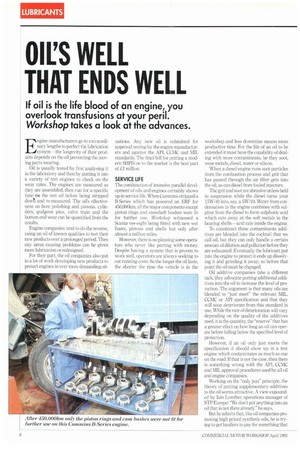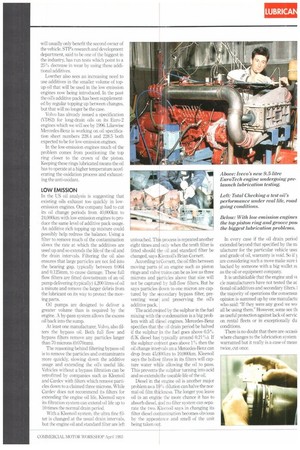OIL'S WELL THAT ENDS WELL
Page 92

Page 93

If you've noticed an error in this article please click here to report it so we can fix it.
If oil is the life blood of an engine, you overlook transfusions at your peril. Workshop takes a look at the advances.
FAngine manufacturers go to extraordinary lengths to perfect the lubrication system the longevity of their products depends on the oil preventing the moving parts wearing.
Oil is usually tested by first. analysing it in the laboratory and then by putting it into a variety of test engines to check on the wear rates. The engines are measured as they are assembled, then run for a specific time elig the test oil before being stripped dove?' and re-measured. The oil's effectiveness on bore polishing and pistons, cylinders,' gudgeon pins, valve train and the bottom end wear can be quantified from the results.
Engine companies tend to do the reverse, using an oil of known qualities to test their new products over a prolonged period. Then any areas causing problems can be given more lubrication or redesigned.
For their part, the oil companies also put in a lot of work developing new products to protect engines in ever more demanding sit uations. Any new oil is submitted for approval testing by the engine manufacturers and against the API. CCMC and MIL standards. The final bill for putting a modern SHPD on to the market is the best part of f.1 million.
SERVICE LIFE
The combination of intensive parallel development of oils and engines certainly shows up in service life. When Cummins stripped a B-Series which has powered an ERF for 450,000Im, all the major components except piston rings and camshaft bushes were fit for further use. Workshop witnessed a Scania vee-eight being fitted with new wet liners, pistons and shells but only after almost a million miles.
However, there is no pleasing some operators who never like parting with money. Despite having a system that is proven to work well, operators are always seeking to cut running costs. So the longer the oil lasts, the shorter the time the vehicle is in the workshop and less downtime means more productive time. For the life of an oil to be extended it must have the capability of dealing with more contaminants, be they soot, wear metals, diesel, water or silicon.
When a diesel engine runs soot particles from the combustion process and grit that has passed through the air filter gets into the oil, as can diesel from fouled injectors.
The grit and soot are abrasive unless held in suspension while the diesel turns your 15W/40 into, say. a 5W/10. Water from wndensat ion in the engine combines with sulphur from the diesel to form sulphuric acid which eats away at the soft metals in the bearing shells—acid rain inside the engine.
To counteract these contaminants additives are blended into the cocktail that we call oil, but they can only handle a certain amount of dilution and pollution before they are exhausted. Eventually the lubricant put into the engine to protect it ends up dissolving it and grinding it away; so before that point the oil must be changed.
Oil additive companies take a different tack, they advocate putting additional additives into the oil to increase the level of protection. The argument is that many oils are blended to "just meet" the relevant MIL, CCMC or API specification and that they will soon deteriorate from this standard in use. While the rate of deterioration will vary depending on the quality of the additives used, it is the quantity, the 'reserve" that has a greater effect on how long an oil can operate before falling below the specified level of protection.
However, if an oil only just meets the specification it should show up in a test engine which contaminates as much as one on the road. If that is not the case, then there is something wrong with the API, CCMC and MIL approval procedures used by all oil and engine companies.
Working on the "only just" principle, the theory of putting supplementary additives to the oil seems attractive. A view expounded by lain Lowther, operations manager of STP Europe: "We don't put anything into an oil that is not there already" he says.
But he admits that, like oil companies promoting high priced synthetic oils, he is trying to get hauliers to pay for something that will usually only benefit the second owner of the vehicle. STP's research and development department, said to be one of the biggest in the industry, has run tests which point to a 25% decrease in wear by using these additional additives.
Lowther also sees an increasing need to use additives in the smaller volume of topup oil that will be used in the low emission engines now being introduced. In the past the oil's additive pack has been supplement ed by regular topping up between changes, but that will no longer be the case.
Volvo has already issued a specification (VDS2) for long-drain oils on its Euro-2 engines which we will see by 1996. Likewise Mercedes-Benz is working on oil specifica tion sheet numbers 228.4 and 228.5 both expected to be for low-emission engines.
In the low-emission engines much of the problem comes from positioning the top ring closer to the crown of the piston. Keeping these rings lubricated means the oil has to operate at a higher temperature accelerating the oxidation process and exhausting the anti-oxidant.
LOW EMISSION In the CS oil analysis is suggesting that existing oils exhaust too quickly in lowemission engines. One company had to cut its oil change periods from 40,000km to 24,000km with low-emission engines to produce the same level of additive pack usage. An additive rich topping up mixture could possibly help redress the balance. Using a filter to remove much of the contamination slows the rate at which the additives are used up and so extends the life of the oil and the drain intervals. Filtering the oil also ensures that large particles are not fed into the bearing gap. typically between 0.064 and 0.125mm, to cause damage. These full flow filters are fitted downstream of an oil pump delivering (typically) 4,200 litres of oil a minute and remove the larger debris from the lubricant on its way to protect the moving parts.
Oil pumps are designed to deliver a greater volume than is required by the engine. A by-pass system allows the excess oil back into the sump,
At least one manufacturer. Volvo, also (-Atees the bypass oil. Both full flow and bypass filters remove any particles larger than 70 microns (0.070mm).
The reasoning behind filtering bypass oil is to remove the particles and contaminants more quickly, slowing down the additive usage and extending the oil's useful life. Vehicles without a bypass filtration can be retrofitted by companies such as Kleenoil and a-irdev with filters which remove particles down to a claimed three microns. While Cardev does not recommend its filters for extending the engine oil life, Kleenoil says its filtration system can extend oil life up to 10 times the normal drain period.
With a Kleenoil system, the ultra fine filter is changed at the usual drain intervals, but the engine oil and standard filter are left untouched. This process is repeated another eight times and only when the tenth filter is fitted should the oil and standard filter be changed, says Kleenoilfs Brian Cornett.
According to Cornett. the oil film between moving parts of an engine such as piston rings and valve trains can be as low as three microns and particles above that size will not be captured by full-flow filters. But he says particles down to one micron are raptured by the secondary bypass filter, preventing wear and preserving the oil's additive pack.
The acid created by the sulphur in the fuel mixing with the condensation is a big problem with all diesel engines. Mercedes-Benz specifies that the oil drain period be halved if the sulphur in the fuel goes above 0.5".■■ (UK diesel has typically around 0.21%). If the sulphur coitent goes above 1% then the oil change intetvals an a Mercedes-Benz can drop from 45,000km to 10,0001un. Kleenoil says the hullo* fibres in its filters will capture water while allowing the oil to pass. This prevents the sulphur turning into acid and so extends the useable life of the oil.
Diesel in the en.gine oil is another major problem as a 10% dilution can halve the normal oil film thickness. The longer you leave oil in an engine the more chance it has to absorb diesel, and no filter system can separate the two. Kleenoil says in changing its filter diesel contamination becomes obvious by the appearance and smell of the unit being taken out. In every case if the oil drain period extended beyond that specified by them; ufacturer for the particular vehicle use and grade of oil, warranty is void. So if 3 are considering such a move make sure i backed by someone with a big wallet st as the oil or equipment company.
It is unthinkable that the engine and IR de manufacturers have not tested the ac tional oil additives and secondary filters.] the majority of operations the consensul opinion is summed up by one manufactu who said: "If they were any good we wo all be using them." However, some see th as useful protection against lack of servic on rental fleets or in exceptionally du conditions.
There is no doubt that there are occasil where changes to the lubrication system warranted but it really is a case of meas twice, cut once.












































































































